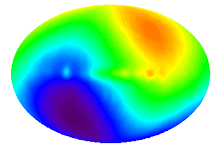Acinetobacter baumannii
MICROBIOLOGY
· Aerobic gram-neg coccobacilli or rods, often mistaken for Neisseria or Moraxella on Gram stain.
· Common in environment (water, soil) and hospital (catheters, lotions, ventilation equipment).
· Grows on standard agar media.
· A. baumannii is the major species of Acinetobacter. Others occasional human pathogens include A. calcoaceticus, A. lwoffi, A. junii, A. johnsonii and A. baylyi .
· A. baumannii is low grade pathogen affecting compromised hosts (immunosuppression, post-surgical, ventilator-associated pneumonia, burn wounds, ICU pts, device-associated infections and malnutrition).
CLINICAL
· Emerging as important global, pan-resistant GNB nosocomial pathogen.
· Clearly pathogenic when recovered from blood and normally sterile body sites.
· Risks: hospitalization, ICU, surgery, antibiotic exposure and catheters.
· May cause nosocomial epidemics from contaminated common sources, e.g., ventilation equipment, catheters, etc.
· Diagnosis by standard aerobic bacterial culture.
· Lab isolations often meaningless (representing colonization) unless from
o normally sterile site,
o found as a dominant pathogen and moderate or heavy growth from potentially contaminated sites,
o outbreak and/or
o good clinical correlation.
SITES OF INFECTION
· Usually a cause of nosocomial infections.
· Pneumonia: nosocomial, especially ventilator-associated.
· Septicemia: often catheter-associated, or consequence of HAP or VAP.
· Wounds: burns, war wounds acquired in Iraq, natural disasters--hurricanes/earthquakes.
· Rare: meningitis (post-neurosurgical), liver abscess, endocarditis, urinary tract infections, brain abscess.
· Community-acquired: reports from Iraqi war theater, one major report from New Zealand.
TREATMENT
Antibiotics (Clin Infect Dis 2010;51:79)
· Antibiotic selection guided by in vitro sensitivity tests--most active: imipenem, ampicillin/sulbactam, colistin, tigecycline and amikacin.
· Imipenem: 0.5-1gm IV q6h, meropenem 0.5-1 gm IV q 8h, doripenem 500 mg IV q 8h.
· Ampicillin/sulbactam: 3 gm ampicillin/1.5 gm sulbactam IV q 6h (sulbactam is the active component).
· Tigecycline: 100 mg IV, then 50 mg IV q 12 h.
· Intrathecal: Polymyxin E 50,000 units/d.
· Pan-resistant isolates: colistin5 mg/kg/d divided q12h IV +/- imipenem or ampicillin/sulbactam.
· Other agents with variable activities: aminoglycosides, cephalosporins, minocycline, rifampin.
· Inhalation: colistin 1-3 mil units q 8h (use immediately after reconstitution) or tobramycin 300 mg twice daily.
skip to main |
skip to sidebar
網誌存檔
-
▼
2011
(110)
-
▼
6月
(110)
- 健康是生命在時空中運轉、運作、轉化物質、能量、信息的歴程中,身、心、靈、家庭、社會的最適的運作狀態。
- 生命的量子動力學機制(quantum mechanics of life)
- 若水自由自在自然活在當下
- 重症:危及生命,潛在危及生命
- 鈣離子是一個多彩多姿的信息攜帶者,它調節細胞活動的許多面項,例如受精作用來創造新生命以及程式化的細胞...
- 鈉離子和水分的動態的平衡恆定。
- 新奇新穎──精靈──神經新生效應(novelty-numinosum-neurogenesis ef...
- 解決一切問題要智慧,知識不行。
- 蒲朗克長度和蒲朗克時間:
- 慢性孤獨會改變基因的活性,孤獨會增加和炎症反應相聯結的基因的活性,孤獨會減少和抗體產生與抗病毒反應相...
- 精靈效應(numinosum effect )
- 精靈效應(numinosum effect )
- 對於生命,我們只加一分自己之所能,決不取一分自己之所欲。
- 寧靜(Aequanimitas):平靜無波的心境。
- 過度自信是造成臨床診斷錯誤和臨床處置決定錯誤的最重要的原因。
- 適應是任何有利於種族延續的特性。
- 複雜系統是由許多不相似的單元組成,這些不相似的單元經由多樣性的相互作用連結,組合而成的網絡系統。
- 複雜企業問題的解決模式:
- 複雜的適應系統的特徵是
- 複雜問題因為複雜、困難衡量評估和新奇,因此阻止我們獲得我們決策所需所依據的好的重要的硬資料。
- 複雜問題解決的藝術
- 樹狀突脊(dendritic spine)是感知認知感覺學習記憶經驗習慣思考思想聯想創造發明的位子所在。
- 神經元樹狀突脊(dendritic spine)是感知、認知、感覺、意識、學習、記憶、經驗、習慣、思...
- 謙卑、敬畏、尊重、憐憫、慈悲、智慧、喜捨是國家領導人應具備最基本的特質。
- 臨命終時有三個重要的條件,
- 醫師的三個大敵:無知、冷漠、墮落。
- 醫療行業的四大特質:
- 臨床醫學是一種不確定的科學。
- 醫生對病人應該有關懷體貼的態度以及「利他主義」 (altruism) 的精神
- 醫生對病人應該有關懷體貼的態度以及「利他主義」 (altruism) 的精神
- 醫道:
- 醫療是一個人與人互動的關懷過程。
- 醫道
- Acinetobacter baumannii
- 最大的、最頂尖的生物目標是個體的生存存活(SURVIVAL)和種族的
- 生命系統的主要特性是合作的電子共振。光合作用是一種量子的過程途徑,它用生物光子做細胞溝通。
- 真實的知識,反應所有由愛所突現的所有正面的因素。
- 致中和法門
- 人類是大自然的微宇宙,而大腦神經元細胞組成人體內在的宇宙。
- 休克病人快速心肺評估和臨床檢查
- 生命由雙螺旋的双股的DNA所調控。DNA位於成對的染色體(CHROMOSOME)上,它們指揮人類的胚...
- 信息一直朝有序的方向演化、進化、轉化、提昇、躍昇、躍進而達永恆的、無限的愛,無限的智慧,無限的知識,...
- 二十一世紀的建構單元是位元(BITS)原子(ATOM)神經元(NEURON)和基因(GENE)也就是...
- 致中和,天地位焉,萬物育焉。中也者,天下之大道、正道,和也者,大不下之達道。喜怒哀樂之未發謂之中,發...
- 匯聚科技(convergence technology)將改善人類的技能、本事的操作績效,幫助人類對...
- 宇宙的基本的建構單元是信息的轉化,而不只是能量物質而已。
- 宇宙估計大約含有十的八十次方(10^80)的粒子(particles)數目,最大的運算能力大約是每秒...
- 最大的、最頂尖的生物目標是
- 健康是活的生命系統的一種適當的適應的最佳的運作狀態。
- 健康是平衡與和諧。
- 整體人類祇佔整個地球總生物質量的百分之零點一(0.1%)
- 人類是十兆個(10 trillion:10*13)有細胞核的體細胞和一百兆個(100 trillio...
- 生命是一場持續地創生、生長、成長、發展、演化、進化、轉化、躍升、學習的歷程。
- 大腦是在混沌的領域中運轉運作
- 腸道中的微生物器官是一個被遺忘的器官
- 人類腸道中大約有1.5公斤多的微生物細菌寄居在其中
- DEHP 的毒性
- 人體的化學組成:
- 心臟-腎臟的損傷(C-K-D)(CARDIO-KIDNEY-DAMAGE)是一種統合的觀念。
- 加護病房中,預防急性腎臟損傷的策略,是維持足夠的有效的循環血容積、足夠的有效的腎臟血液灌注,避免腎臟...
- 加護病房中造成急性腎臟損傷的普通的腎臟毒素:
- 加護病房中造成急性腎臟損傷的普通的原因:
- 生命運轉的原則(life’s principles)
- 生命的運轉原則(life’s principles)
- 在危急重症的病人的各種不同的侵犯因素中,腎臟是最普通的被犧牲的器官。
- 低鈉血症的致病機轉和診斷
- 急性代謝性酸中毒的副作用:
- 要在一個充滿回饋和危險的世界中生存存活,一定需要適當的行為反應。
- 將自然視為一種模組,導師,衡量評估的標準(looking at nature as a model,...
- 粒線體是細胞鈣離子信息網絡的集線器。
- 粒線體的鈣離子是細胞生命生存和細胞死亡的調控者。
- 輪迴解脫者惟一之所。
- 藥物誘發引起的急性腎臟損傷的分類
- 藥物誘發引起的急性腎臟損傷的分類
- 慢性代謝性酸中毒的副作用:
- 避免低的有效的循環血容積、避免腎臟毒性的藥物、避免對比劑的使用,是加護病房中,預防急性腎臟損傷的重要策略。
- 腸胃道是人類最大的免疫器官。
- 如何創造和維持一個快樂、怡悅的心智和心靈。
- 2010年美國心臟醫學會最新心肺復甦術和緊急心血管照護指引(2010 American Heart ...
- 2010年美國心臟醫學會最新心肺復甦術和緊急心血管照護指引(2010 American Heart ...
- 心肺復甦術(CPR)
- 心肺復甦術(CPR)
- 成年人的基本的生命支持術(成年人的基礎救命術)(Adult Basic Life Support)。
- 去顫電擊(defibrillation)
- 原核生物(prokaryotes): 地球上看不見的絕大多數的生物
- 原核生物(prokaryotes): 地球上看不見的絕大多數的生物。
- 心肺復甦術(CPR)
- 宿主和他們的微生物群體已經演化成一種互利共生的關係,這一種互利共生的關係,建立和維持在黏膜表面的免疫...
- 2010年美國心臟醫學會最新心肺復甦術和緊急心血管照護指引(2010 American Heart ...
- 生命是一個量子場,將我們和宇宙的能量場和信息場連接聯結。
- 平安、安全、生存存活的能力(Safety,Security,Survivability)
- 意識是在古典的世界和量子的世界的邊緣突現的過程。
- 組成生命的元素
- 敗血症是對感染產生沒有控制的炎症反應的一種嚴重的疾病。
- 低鈉血症
- 生物系統天生是一個複雜的適應系統。
- 癌症細胞的特性:
- 細胞網絡:
- 低鈉血症是臨床實務上最普通最常見的電解質不平衡,尤其在年老的族群。
- 接受血液透析治療的末期腎臟疾病病人的猝發性心因性死亡(SUDDEN CARDIAC DEATH-SCD)
-
▼
6月
(110)

沒有留言:
張貼留言